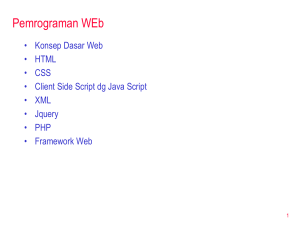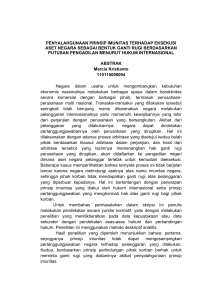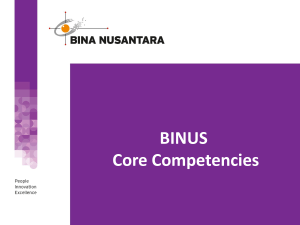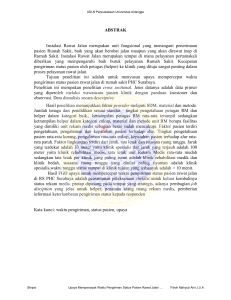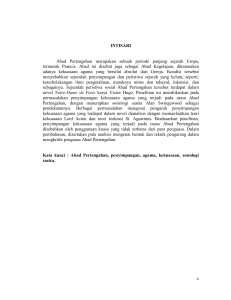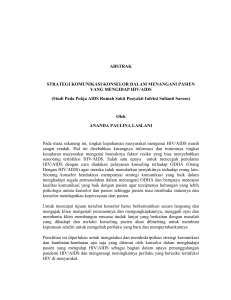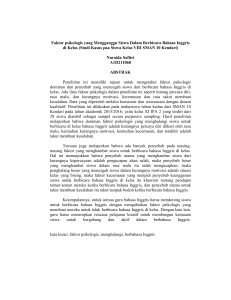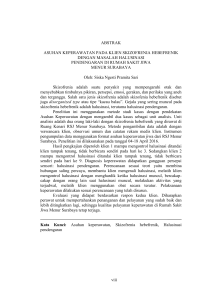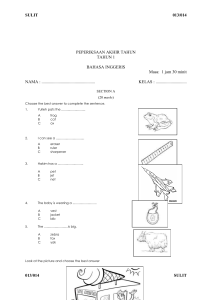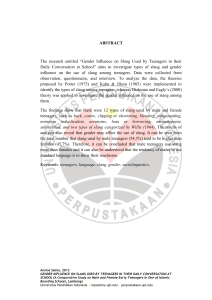KELOMPOK BERESIKO TINGGI dalam KEHAMILAN
advertisement
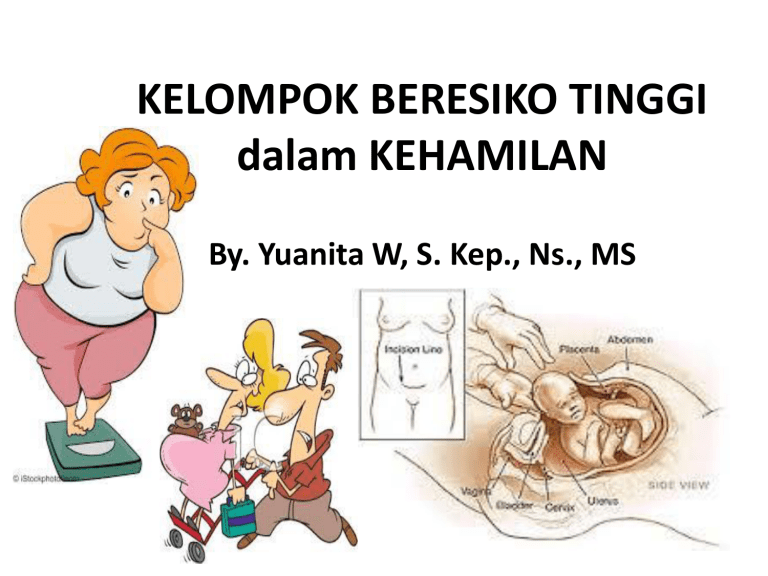
KELOMPOK BERESIKO TINGGI dalam KEHAMILAN By. Yuanita W, S. Kep., Ns., MS OUTLINES 1. 2. 3. 4. Review KEHAMILAN Kehamilan pada Remaja Kehamilan pada Usia Tua Kehamilan dengan Obesity KEHAMILAN FERTILIZATION FETUS DEVELOPMENT (9 MONTHS IN THE WOMB) TANDA & GEJALA KEHAMILAN ADAPTASI FISIOLOGIS KEHAMILAN 1 2 REMAJA • WHO: 12-18 tahun • BKKBN: 10-21 tahun • 20% penduduk indonesia adalah remaja (2013) • Masa transisi dari anak-anak menjadi orang dewasa. • Perubahan fisik sedang terjadi bersamaan dengan identitas seksual. • Psikologis: masa pencarian identitas diri, keinginan untuk bebas, kebebasan untuk berpikir dan bertindak. KARAKTERISTIK IBU MUDA DATA DUNIA - Low level of education, - Rural dwelling, - Low income. Source: Growing up global: The Changing Transitions to Adulthood in Developing Countries (National Research Council, 2005). More than 1/5 of women in the poorest regions have a child by age 18. 35 30 25 20 15 10 5 0 West Asia & North Af rica South America Carribean & Central America South, Central & South East Asia Eastern & Western & Southern Middle Af rica Af rica Source: Tabulations of demographic & health surveys from 51 countries,1990-2001. (National Research Council, Growing up global: The Changing Transitions to Adulthood in Developing Countries, 2005). Greater likelihood of maternal mortality 1400 1200 1000 800 600 20-34 years 15-19 years 400 200 0 The risk of dying from Ethiopia B'desh Brazil pregnancy-related causes is twice as high for adolescents Source: Safe Motherhood Initiative Factsheet, 1998. aged 15-19, as for older women. Adolescent Sexuality & Childbearing. KEHAMILAN PADA REMAJA (KR) Angka kejadian: Di Indonesia, 3, 006 respondent remaja (17-24 tahun) 20.9% hamil diluar nikah dan melahirkan sebelum menikah (Penelitian Australian National University - Universitas Indonesia, 2011). BKKBN BKKBN(2010), (2006),kehamilan kehamilanremaja remajadiluar diluarnikah nikah 3,2% 2,3%karena karenadiperkosa diperkosa karena sama-sama sama-sama mau mau yang yang direncanakan direncanakan 12.9% 8.5% karena 45% 39%karena karenasama-sama sama-samamau mauyang yangdiditidak tidakrencanakan rencanakan 22.6% karena seks bebas 18.5% karena seks bebas KEHAMILAN YANG TIDAK DIINGINKAN/TIDAK DIRENCANAKAN/DILUAR PERNIKAHAN FAKTOR YANG TERKAIT dengan KR Usia pertama haid terlalu dini. Peer pressure terkait aktivitas seksual. Riwayat sexual abuse. Minimnya pengetahuan mengenai kontrasepsi. Merasa sudah “independen & fredom”. Kemiskinan. Budaya. Kurangnya “role model” yang baik. Penggunaan obat-obatan dan alkohol. Situasi rumah yang tidak baik “broken home”. Early dating tanpa pantuan yang baik. (Alan Gittmacher Institude, 2012) DAMPAK KR (1) • Putus sekolah: kemampuan finansial sebagai orang tua • Ketidak siapan emosional & psikologis: – Pertumbuhan tanpa kehadiran ayah – Bayi lahir dengan BB rendah atau kematian neonatus – Perawatan kesehatan yang tidak memadai – Resiko penelantaran & pembuangan anak • Resiko kematian ibu hamil dibandingkan ibu hamil usia 20-24 tahun: – usia 10-14 tahun 5 x lebih tinggi – usia 15-19 tahun 2 x lebih tinggi Clinical causes of maternal mortality among adolescents – 1/3 • Unsafe abortion1 – Study from a teaching hospital in Nigeria (over a 10 year period) – abortion was the cause of 36.9% of maternal deaths in 10-19 year olds • Obstructed labour2 – Strong indications of higher risk in mothers below16 years since pelvis is still not fully developed 08_XXX_MM13 • Many studies use caesarean section incidence as a proxy for obstructed labour – many studies in Africa and one in India found a greater likelihood of this in adolescents than in adults Sources: 1.Ujah, 2005; 2. WHO, 2004 Clinical causes of maternal mortality among adolescents – 2/3 • Hypertensive disorders – Two studies – one in Turkey1 and one in Mozambique2 – found an increased incidence of hypertensive orders in adolescent mothers, when compared to non-adolescent mothers. However, other studies3 have shown no difference 08_XXX_MM14 • But they did not standardize for parity Sources: 1. Bozkaya et al, 1996; 2. Granja et al, 2001; 3. Ministerio de Salud, El Salvador, 2007 Clinical causes of maternal mortality among adolescents – 3/3 • Injuries – suicide and homicide Deaths per 1000 women-years 08_XXX_MM15 – In a study in Bangladesh, violence-related injuries were highest among pregnant adolescents1 10 9 8 7 6 Pregnant Not pregnant 5 4 3 2 1 0 15-19 20-24 25-29 30-34 35-44 Sources: 1. Ronsmans et al, 1999 DAMPAK KR (2) • Anemia – Large, high quality study in Latin American & Caribbean found that mothers below16 years old had a 40% increased risk of anemia, compared to mothers age 20241 08_XXX_MM16 • There were no significant differences for older adolescents Sources: 1. Conde-Agudelo, Belizán & Lammers, 2005 DAMPAK KR (3) • Malaria – In a recent study in Mozambique, malaria was the cause of death in twice as many adolescent mothers (26.9%) as non-adolescent mothers (11.7%)1 08_XXX_MM17 • Obstructed labour – fistulae – Studies in Africa have shown that 58-80% of women with obstetric fistulae are under age 20, with the youngest aged only 12 or 13 years2 – 59% and 27% of fistulae cases occurred in women below 15 & 18 years respectively3 Sources: 1. Granja et al, 2001; 2. Ministry of Health, Kenya, and UNFPA, 2004; 3. Ampofo, 1990 DAMPAK KR (4) • Adolescents are at an increased risk for pre-term labour & delivery, compared to older women. • Babies born to adolescent mothers are more likely to be of low birth weight. • Babies born to adolescent mothers are at an increased risk of perinatal & infant mortality. Source: Adolescent pregnancy – Issues in adolescent health and development. Geneva. WHO 2004. KESIMPULAN DAMPAK KR • IBU: – – – – – – – – – Un-adequate Prenatal-care Gangguan pada tekanan darah (Pre-eklamsia-Eklamsia) Anemia defisiensi Besi Abortus Sexually Transmitted diseases Kanker pada organ reproduksi Premenstruasi syndrom Disproporsi tulang panggul Post-partum depression • BAYI/JANIN: – Kelainan kongenital – Berat badan lahir rendah – Prematur baby PERAWATAN LANJUTAN (1) • Use of antenatal care (ANC) – A systematic review of maternal health care use • Women under 20 years are less likely to receive ANC during the first trimester (high quality studies from Jamaica, Brazil, South Africa, India/Kerala, Ecuador)1 – In the Philippines, only 29% of mothers below18 received ANC, compared to 81% of mothers aged 20-302 08_XXX_MM20 • Use of facility-based delivery – Significant age differences in favour of older women (high quality studies from India, Morocco, Guatemala)1 Source: 1. Say L, 2007 (unpublished data); 2. Dela Cruz, 1996 PERAWATAN LANJUTAN (2) 08_XXX_MM21 • Use of skilled delivery assistance – No age-difference appears to exist (high quality studies from Bangladesh, India, Nepal)1 • Higher education (both woman’s and her partner’s), problems during delivery, living standards, and women’s autonomy are more significant in influencing the receipt of assistance from a skilled health worker during delivery – In an older review, mothers below the age of 19 were significantly less likely than mothers aged 19-23 to receive skilled childbirth care in 7 of 15 countries2 Source: 1. Say L, 2007 (unpublished data); 2. Family Health International, 2003 PERAWATAN LANJUTAN (3) Within a multifaceted approach, we need to ensure that every adolescent is able to obtain the health information & services she needs. – We need to ensure that contraceptive services, antenatal services and skilled care at delivery are widely available. – We need to ensure that these services are accessible to adolescents. – We need to ensure that health care providers who provide these services are trained and support to respond to adolescents competently & with sensitivity. PERAWATAN LANJUTAN (4) 1. Membantu menyelesaikan masalah ekonomi & social: skillfull & working. 2. Pengembangan nilai-nilai personal. 3. Membantu mereka menciptakan hubungan yang baik dengan orang lain. 4. Membuat mereka mengenti & nyaman terkait dengan perubuhan tubuh mereka. (Heaman, 2010) SOLUSI x no” mendapatkan • Menyarankan untuk“Say segera Prenatalsaid: care. Evidence peran orang tua, peer group, komunitas • Jauhi rokok, alkohol mereka & obat-obatan. • Mencari dukungan emosianal yang memadai. PENCEGAHAN KEHAMILAN REMAJA: Meningkatkan peran ortu dalam memonitor pergaulan remaja. Mencegah pergaulan bebas termasuk penggunaan obat-obatan. Pendekatan spiritual. Meningkatkan peran BKKBN dalam kontrasepsi remaja! FAKTA: UU RI no. 1 tahun 1974 tentang perkawinan Pasal 7 ayat 1, perkawinan diizinkan jika usia mempelai laki-laki 19 tahun dan mempelai perempuan 16 tahun. Tahun 2012 di Indonesia, 48% remaja menikah usia 16-20 tahun. 5% menikah diusia kurang 15 tahun. HEALTH EDUCATION TO PREVENT KR PERILAKU YANG BERESIKO TERHADAP TERJADINYA KEHAMILAN KEBEBASAN REMAJA, PENDAMPINGAN REMAJA, PENUNDAAN BERHUBUNGAN SEKSUAL. GAMBARAN KEHIDUPAN: KARIER, KULIAH, PENDIDIKAN, JALAN-JALAN. SEXUAL TRANSMITTED DISEASES " For too long, when an adolescent becomes pregnant, we have pointed the finger at her. It is time that we pointed the finger at ourselves. If a girl gets pregnant that is because we have not provided her with the information, education, training and support she needs to prevent herself becoming pregnant." Pramilla Senanayake, Former assistance Director International Planned Parenthood Federation. APA YANG ANDA PIKIRKAN MENGENAI MASALAH INI????? Is it public problem???? The relevance of adolescent pregnancy to the Millennium Development Goals (MDGs) • Adolescent pregnancy contributes to maternal mortality • Adolescent pregnancy contributes to perinatal and infant mortality • Adolescent pregnancy contributes to the vicious cycle of poverty. The relevance of adolescent pregnancy to the Millennium Development Goals (MDGs) • Adolescent pregnancy contributes to maternal mortality • Adolescent pregnancy contributes to perinatal and infant mortality • Adolescent pregnancy contributes to the vicious cycle of poverty. KEHAMILAN USIA TUA FASE PERKEMBANGAN MANUSIA prakelahiran (prenatal period) saat dari pembuahan hingga kelahiran. Bayi (infacy) kelahiran hingga 18 atau 24 bulan. Awal anak-anak (early chidhood/ periode prasekolah) masa bayi hingga usia lima atau enam tahun Pertengahan dan akhir anakanak (middle and late childhood/sekolah dasar) 6 hingga 11 tahun, yang kira-kira setara dengan tahun-tahun sekolah dasar. Masa remaja (adolescence) 10 hingga 12 tahun dan berakhir pada usia 18 tahun hingga 22 tahun. Awal dewasa (early adulthood) usia 11 tahun atau awal usia 20 tahun dan yang berakhir pada usia 30 tahun. Pertengahan dewasa (middle adulthood) 35 hingga 45 tahun dan merentang hingga usia 60 tahun. Akhir dewasa (late adulthood) -usia 60 atau 70 tahun dan berakhir pada kematian. PERTENGAHAN DEWASA (MIDDLE ADULTHOOD) Bermula pada usia kira-kira 35 hingga 45 tahun dan merentang hingga usia 60 tahun. Masa untuk memperluas keterlibatan dan tanggung jawab pribadi dan sosial seperti membantu generasi berikutnya menjadi individu yang berkompeten, dewasa dan mencapai serta mempertahankan kepuasan dalam berkarir. Kekuatan fisik dan kesehatan mulai menurun KEHAMILAN PADA USIA TUA ELDERLY PRIMI: wanita yang sedang hamil pertama saat usia diatas 35 tahun. Phenomena ”elderly primi” terus meningkat: Menikah lambat Menunda kehamilan untuk berkarier RESIKO & KOMPLIKASI IBU: Infertility Spontaneous abortion Gestational diabetes Chronic hipertensi Pre-eklamsia atau eklamsia Preterm labor Mulatiple pregnancy Surgical birth Plasenta previa JANIN/BAYI: Genetic disorder Intra Uteri Growth Restriction (IUGR) Low APGAR scores (Bayrampour & Heaman, 2010) RESIKO & KOMPLIKASI (1) Abruptio placentae the implanted placenta prematurely separates from the uterine wall. Associated with hypertension, trauma, increased amounts of amniotic fluid, multiples, and cocaine use. Placenta previa placenta is positioned close to or over the internal cervical os. Abnormal vascularization is thought to play a part. Associated with previous C-section, increased maternal age, and increased number of previous pregnancies. RESIKO & KOMPLIKASI (2) Preeclampsia mother develops sustained HTN (systolic ≥ 140 mmHg or diastolic ≥ 90 mmHg) with proteinuria brought on by pregnancy, usually in the second half of gestation. It can affect many of the mother’s body systems, and can cause problems with the fetus by decreasing placental perfusion. Associated with previous miscarriage and the extremes of reproductive age. RESIKO & KOMPLIKASI (3) Eclampsia usually occurs in a woman who has preeclampsia. The defining characteristic is convulsions not caused by a neurological disorder. Most cases occur within 24 hrs of delivery, but can happen up to 10 days after birth. Can cause maternal death. Chronic hypertension mother has HTN before the 20th week of gestation, or beyond 6 weeks after delivery. Usually caused by essential HTN, the risk for which increases with age. Increases risk of developing preeclampsia and eclampsia. RESIKO & KOMPLIKASI (4) Diabetes type I, type II, or gestational diabetes can occur in pregnancy. Diabetes in pregnancy can lead to preeclampsia. It can also cause ketoacidosis and retinopathy in the mother. It can lead to congenital anomalies, IUGR, macrosomia (> 4000 g) which can cause problems in delivery, and can lead to a hypoglycemic neonate. Uncontrolled diabetes during pregnancy increases the risk of spontaneous abortion (< 20 wks) and stillbirth (≥ 20 wks). Type II diabetes may be a comorbidity in a mother of advancing age. RESIKO & KOMPLIKASI (5) Chromosomal abnormalities may be due to the deteriorating quality of the ova with advancing age (Heffner, 2004). Types of abnormalities: Down syndrome (trisomy 21) Edwards syndrome (trisomy 18), dll Each of these chromosomal abnormalities causes different characteristic changes of the fetus, various mental changes, and altered life expectancies of the neonate. The incidence of Down syndrome among all newborns is about 1:800. For mothers age 35, the incidence is 1:385, and for mothers age 45, the incidence is 1:33 (Beckmann et al., 2006). Men with advancing paternal age also have an increased risk of producing a child with an autosomal dominant disease, like Marfan syndrome, because of increased genetic mutations (Heffner, 2004). RESIKO & KOMPLIKASI (6) Infertility can be caused by maternal issues associated with age such as premature ovarian failure, perimenopause, and menopause. Can also be due to anovulation, anatomical defects, or a variety of other problems in the female. May also be due to abnormal spermatogenesis in the male. SOLUSI BOLEHKANH KEHAMILAN ELDERY PRIMI????? 1. 2. 3. 4. 5. 6. Kehamilan yang terencana YA TIDAK √ Reguler Prenatal Care Makan healthy diet Kenaikan BB diatur Tetap beraktivitas Screening untuk gangguan Genetic KESIMPULAN RELATIONSHIP BETWEEN MATERNAL AGE AND PERINATAL OUTCOMES 08_XXX_MM42 • Rigorous study in Latin American & the Caribbean showed that: – Adolescent mothers had higher risks of regular & very preterm delivery, & of giving birth to infants that were low & very low birth weight, as well as small for gestational age (compared to women aged 20-34) – Infants born to women below 16 years faced a 50% increase in risk of early neonatal death – All risks increased as maternal age decreased Source: Conde-Agudelo, Belizán & Lammers, 2005 KEHAMILAN DENGAN OBESITAS FAKTA OBESITAS Pada tahun 2013: DUNIA Orang dengan kegemukan di dunia berjumlah 2,1 miliar negara maju yang gemuk kebanyakan adalah laki-laki INDONESIA Indonesia masuk urutan 10 besar dengan orang kegemukan berjumlah 40 juta orang atau setara seluruh penduduk jawa barat Indonesia yang gemuk kebanyakan adalah PEREMPUAN OBESITAS OBESITAS: lemak tubuh yang menumpuk sehingga Body Mass Index (BMI) lebih dari 30 kg/m2. BMI = BMI < 18.5 18,5-22,9 ≥23.0 23.0-24.9 25.0-29.9 ≥30.0 𝑩𝑩 𝑻𝑩𝟐 KATEGORI Berat badan kurang Berat badan normal Kelebihan berat badan Beresiko obesitas Obesitas I Obesitas II (center of obesity research and education, 2007) OBESITAS: Meningkatkan masalah kesehatan. Menurunkan angka harapan hidup. KENAIKAN BB SELAMA HAMIL KATEGORI STATUS NUTRISI UNDERWEIGHT (BMI <18.5) Beresiko melahirkan bayi BBLR PENAMBAHAN BB 28-40 pound NORMAL WEIGHT (BMI 18.5-24.9) 25-35 pound Overweight (BMI 25-29.9) 15-25 pound Obese (BMI >30) 11-20 pound IMO, 2009; IMO, 2010 KEHAMILAN DENGAN OBESITAS (KO) Kelebihan jaringan lemak yang ada dalam tubuh dapat meningkatkan over produksi hormon estrogen Sekitar 10 persen perempuan yang kesulitan hamil disebabkan oleh PCOS (polycystic ovarian syndrome). DAMPAK DARI KO 1. 2. 3. 4. 5. 6. 7. 8. Gestational Diabetes Hipertensi Fetal Macrosomia High risk Post partum infection Post date High risk SC Meningkatkan resiko maternal mortaliy High risk Post partum Hemorrhagic (Hull, Montgomery, Vireday, & Kendall-Tackett, 2011) RESIKO & KOMPLIKASI IBU Miscarriage Thromboembolism Gestational diabetes Pre eclampsia Dysfunctional labour Caesarean section Wound infection Anaesthetic complications Maternal mortality BAYI/JANIN Congenital malformation Fetal macrosomia Shoulder dystocia Stillbirth Neonatal death Neonatal morbidity i.e. NICU admission Reduced rates of breast feeding MANAGEMENT KO (1) Optimise weight before pregnancy Educate & advise all women with BMI>30 to lose weight before conception Weight loss >4.5 Kg before pregnancy reduces the risk of gestational diabetes by 40% Dietary Supplementation Folic acid 5 mg/day for -1 to +3 months of pregnancy Vitamin D 10 ug/day (? Required for a sun-loving Aussie) Measure and calculate BMI at first ANTENATAL CARE Preferably before 12w Don’t rely on self estimates of height & weight Dietary Advice MANAGEMENT KO (2) 1) Recommend daily physical activity & reinforce 2) Provide detailed, accurate and specific pregnancy risk advise to all women with BMI>30 3) Women with BMI>35 need obstetrician-led Delivery Unit 4) Discuss & document intrapartum risks and plans management 5) Induction of delivery only for obstetric indications 6) Requests for VBAC require individual assessment 7) IV access in labour 8) Active management third stage 9) Subcutaneous suture if Caesarean is required 10)Special education and support for breastfeeding should begin antenatally 11)Encourage postnatal weight loss or refer TERIMAKASIH

